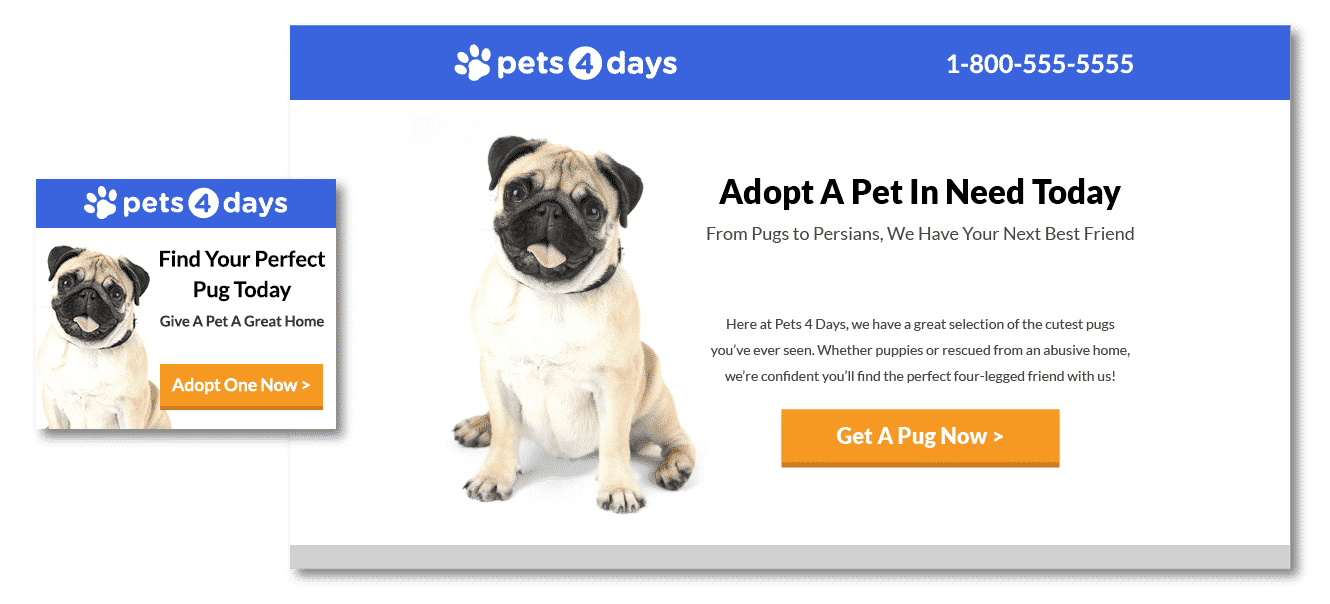How to Improve Your Ad-Landing Page Message Match
by Aden Andrus • December 3, 2019
Whether you’re running ads on Google, Facebook, Twitter, Pinterest or somewhere else, the success or failure of your online advertising depends largely on your ability to put the right message in front of the right people at the right time.
However, it doesn’t stop there.
Your advertising message sets certain expectations and if there isn’t good message match between your ads and your landing page, people won’t stick around to convert. So, if you want to get more out of your advertising, one of the first places you should look is at your ad-landing page message match.
But what exactly is good message match? How does it work? And, more importantly, how do you apply it to your ads and landing pages?
Don’t worry, in this article, we’re going to answer all of those questions and show you how to use message match to take people from impression-to click-to conversion. Sound like a plan? Let’s get started!
The Art of Conversion Rate Optimization
Message match is at the heart of something advertisers refer to as conversion rate optimization (CRO). In a nutshell, CRO is the art and science of convincing your traffic to do what you want them to do—aka, convert.
That conversion might be purchasing your product, filling out your form, calling your business, opening a chat, downloading an eBook, signing up for a webinar, visiting a certain page or any other action that provides value to your business. But, regardless of what your specific conversion may be, the goal of your advertising efforts is to get as many people as possible to do it.

Unfortunately, conversion rate optimization can sometimes be a bit tricky. You are not your target customer, so it can be hard to predict what advertising message and landing page content will produce the best results. To handle this, CRO experts—like our team here at Disruptive—test different versions of landing pages to determine which version gets the most conversions.
But how do you know what to test?
To be honest, there are all kinds of people out there who will tell you “this tweak increased conversions by 250%” or “here’s a trick that drove 100 new leads a day for my business!” As exciting as these case studies are, though, their results often don’t translate well to other businesses. After all, conversion rate optimization is all about optimizing your landing pages for your audience, so there’s no guarantee that what worked for another business in another industry will work for you.
Instead, it’s usually more helpful to focus on general principles and core concepts that show up in a variety of successful tests. At Disruptive, we’ve run thousands of tests and we’ve found that principles are far more useful for optimizing your pages than trying to apply someone else’s optimizations to your own site.
And, what’s one of the most widely applicable principles we’ve seen? Message match.
If you think about it, this just makes sense. The best marketing helps customers through their buyer journey—the road from first impression to actually making a purchase. If that journey isn’t consistently focused on your customers’ needs and pain points, they’ll get lost, frustrated and give up.
On the Road to Conversion
To illustrate why message match is so important, let’s take a look at an offline example. As mentioned above, the concept of message match isn’t limited to online advertising—it’s a key part of your buyer’s journey, no matter where or how you’re advertising.
So, for the sake of this example, let’s say you’re literally on a buyer’s journey. You’re on the road one morning when you spot a billboard for Joey’s Diner advertising “The Best Pancakes in the World!”

Check out those mouthwatering pancakes! It doesn’t take long for you to realize just how hungry you are and how good pancakes sound. You can almost smell them!
Eager to fill your face with buttery, syrupy goodness, you take the next exit and head over to the restaurant. Wiping a bit of drool off your lip, you throw open the door to the restaurant and smell the unmistakable scent of…onion rings.
Wait, what?
The billboard promised pancakes. You came for pancakes. You want pancakes! Where are the pancakes?
Frantically, you grab a menu and search for those mouthwatering pancakes, but there’s no sign of them on the menu, either. Feeling betrayed, you hop back in the car, pull out your phone and start looking for an iHop to satiate your pancake cravings.
Was there a problem with the billboard? Not at all! It did a great job of helping you recognize your hunger and your longing for flapjacks. So why didn’t you buy? The answer is simple: Joey’s Diner failed to deliver on their advertising message.
Now, there might be a good reason why Joey’s failed to deliver. Maybe they only sell pancakes on their breakfast menu and you arrived too late for breakfast. Maybe they stopped selling pancakes a while back but still had time left on their billboard rental. Who knows?
And, to be honest, it doesn’t really matter. You, the customer, were led to expect something and Joey’s failed to deliver. At this point, it doesn’t matter how good Joey’s onion rings are. You don’t want onion rings, you want pancakes and you’re frustrated that Joey’s got your hopes up for nothing.
Do you see why message match is so important? It doesn’t matter whether it’s a billboard or a paid search ad, if your customer journey doesn’t provide a consistent, relevant experience, people won’t buy. They’ll get lost, upset or off-track…and none of those are good for your conversion rate.
Message Match in Online Marketing
Of course, with offline marketing channels like billboards, there are a lot of factors you can’t control that can make it hard to maintain message match. You don’t have a ton of control over who sees your ads, when they see them or where they end up afterwards.
With online marketing, however, you have all kinds of control. You choose who you target with your ads, along with where and when they show up. And, most importantly, you can control exactly what they see after they click on your ad.
As a result, the level of message match between your ads and your landing pages is entirely up to you.
You don’t have to be Joey’s diner. If you set your landing pages up right, you can set an expectation with your ads and then perfectly meet that expectation with your landing pages. So, if you have a marketing message that drives a lot of clicks, you can optimize your landing pages to match that message. Or, if you have a particularly compelling argument on your landing page, you can create ads that bring in the ideal traffic for that page.
Take the following retargeting ad and landing page, for example:

Here, the advertising message carries directly across from the ad to the landing page. Someone who clicked on this ad would immediately feel like they were in the exact right place. They clicked on an ad for pug adoption and ended up on a landing page for pug adoption. The landing page provides more information and gives users a way to act, but the messaging is completely consistent.
In contrast, compare the ad and landing page above to the one below:

There are definitely some consistencies between the two. At first glance, the landing page seems to match the ad—at least in terms of imagery—but things start to break down when you look at the actual copy.
The core message in the ad is pretty specific: “Find Your Perfect Pug Today”. However, the headline and subheadline on the landing page don’t just talk about pugs—they talk about all kinds of pets.
For a user, this can be kind of disorienting. They clicked because they’re interested in pug adoption, but once they arrive on the page, they’re confronted with a much broader set of options. This level of message match can work, but it certainly won’t be nearly as compelling as the message match in the first example.
However, here’s an example of the sort of message match that you often see in advertising:

As with our Joey’s Diner example, this is a clear message mismatch. People click on a blue ad for pugs and ended up on a red page for cats? To make matters worse, the headline, subhead and CTA do not match at all. The only way this could be more confusing would be if the page was advocating euthanasia!
Now, this example might seem a little extreme, but if you pay attention to the ads you click on, this sort of message mismatch is more common than you might think. Many businesses offer sales and promotions in their marketing, but don’t mention those sales or promotions anywhere on their actual landing page! Or, they might have a central message in their ad that really doesn’t show up on their landing page.
Regardless of the reason, if your ad messaging doesn’t match your landing page messaging, you’ve got a recipe for disaster. If your landing page doesn’t feel right to your traffic (aka, doesn’t match the expectations set by your ad), most people won’t stick around.
There should be no surprises in your customer journey, and this is particularly important when people are just starting to get familiar with your business. So, if you want to maximize your conversion rate, is it any wonder that one of the best places to start is with your ad-landing page message match?
Conclusion
The moral of the story is: if you’re advertising pancakes, sell pancakes. If you’re advertising pug adoption, don’t send traffic to a page featuring cats!
Great online advertising is all about message match. People click on your ads because they’re looking for something specific. If they don’t get it, they’ll leave. You paid to get them to your site, so don’t waste the clicks on the wrong landing page.
By the way, if you’re looking for help developing ads and landing pages with great message match, let us know here or in the comments! We’d love to help you optimize your conversion rates and the best possible results from your campaigns.
What do you think of “message match”? Is it a key part of your advertising and landing page development strategy? What advice would you add to this article? Leave your thoughts in the comments.





